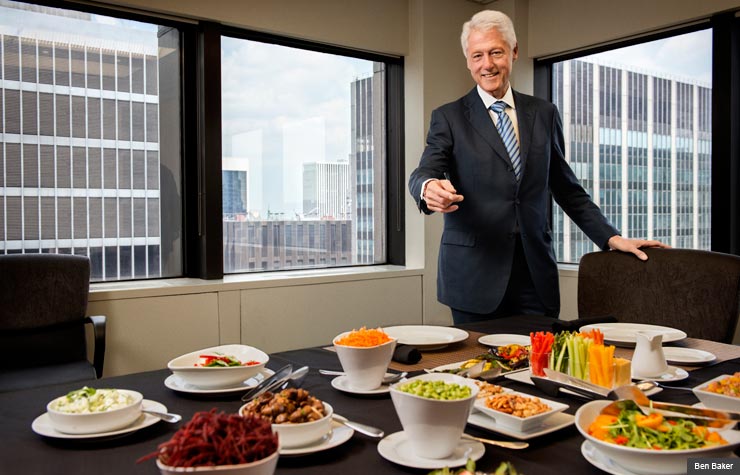AARP Hearing Center


When Bill Clinton invited me to lunch in May, I knew better than to expect fried catfish or barbecued ribs. The former president is now a devoted vegan, meaning no meat, fish or dairy products, and he has pursued a healthier way of life for more than three years. While I figured our lunch menu might be bland, that would be a small price to pay for private time with a world leader who is anything but.
As it happens, the fit, trim and sharply attired Clinton, whom I've come to know well during more than two decades covering his career, is his usual gregarious, charismatic self. But a bland menu? Not even close.
As we enter a private room overlooking Manhattan's busy Rockefeller Center, I'm struck with a dazzling kaleidoscope of a dozen delicious dishes: including roasted cauliflower and cherry tomatoes, spiced and herbed quinoa with green onions, shredded red beets in vinaigrette, garlicky hummus with raw vegetable batons, Asian-inspired snow pea salad, an assortment of fresh roasted nuts, plates of sliced melon and strawberries, and rich, toothsome gigante beans tossed with onions in extra-virgin olive oil.
Get Ready, Get Set — Go Vegan!
Dine like Bill Clinton does. Check out great recipes for hummus, quinoa, beets, cauliflower, snow peas, beans and more.


Subscribe to the AARP Health Newsletter
The luncheon banquet gives a whole new meaning to the dreaded cliché "Eat your vegetables." And this is exactly what Clinton, who is taking on America's obesity epidemic with the same passionate commitment he brought to the presidency, wants.
As I gawk, he smiles. "This looks pretty good, doesn't it?" Clinton asks. It looks better than good. We sit down and with great relish start passing plates back and forth. He favored the quinoa; I loved the roasted cauliflower and snow peas; and we both liked the beans.
The road to a healthier diet
At age 66, Bill Clinton still travels and works at a pace that completely exhausts staffers who are two or three decades younger. Yet, while coping with heart disease and the usual complaints of aging, he has managed to change his diet drastically, lose more than 30 pounds and keep the weight off. If he can do all that, then maybe there's hope for the rest of us baby boomers — and Americans of all ages — whose eating and exercise habits (and medical expenses) worry him a lot.
I first noticed a change in Clinton's eating habits when we were in Capetown, South Africa, back in July 2010. (I have been covering his extraordinary postpresidential career since 2005, interviewing him frequently and traveling with him across Africa, Europe and the Mideast, as well as the United States.) We were all preparing to dig into a tempting dinner sent up to the former president's suite from a very fine restaurant in the hotel. Sitting down next to him, I glanced at his plate and saw none of the steak, shrimp, fish or chicken on the buffet — just a tangle of green lo mein noodles and a pile of broccoli.
"Is that all you're eating?" I blurted.
"That's right," he replied. "I've stopped eating meat, cheese, milk, even fish. No dairy at all." He smiled and yanked on his waistband. "I've lost more than 20 pounds so far, aiming for about 30 before Chelsea's wedding. And I have so much more energy now! I feel great." (He achieved his ideal weight in time for his daughter's marriage to Marc Mezvinsky on July 31, 2010.)

































































More on Health
Got a Beef With Milk? Or Just Want More Options?
Discover the health benefits of 5 dairy substitutes.